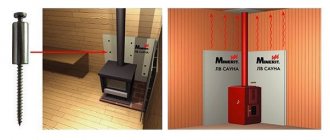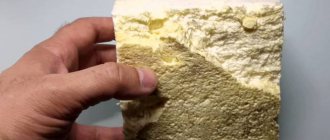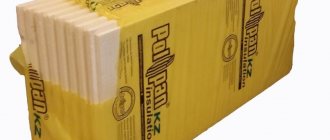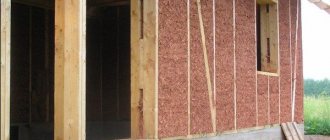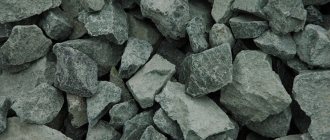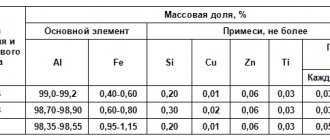One of the main indicators of building quality is fire safety. The performance of any building is enhanced by fire-resistant foam, which is an excellent insulator and protection against fire, smoke and toxic gases. The material is a ready-to-use polyurethane foam sealant, which polymerizes under the influence of atmospheric moist air, acquiring hardness and rigidity.
Figure 1. Fire-resistant foam.
Compound
The polyurethane mixture contains substances that provide protection from fire and high temperature:
- foaming agents that promote a rapid increase in foam volume;
- gas for pushing the composition out of the cylinder;
- catalysts that allow the composition to quickly expand in volume after application;
- flame retardants, giving the material resistance to fire and high temperatures;
- stabilizers ensuring uniform application and stability of the foam on any substrate;
- dyes to indicate the fire resistance of the foam: pink or red.
Important! Fire-resistant foam may be inferior to regular foam in terms of foam formation.
Selection rules
First of all, you need to clearly understand for what purposes these products will be used, because for reliable fixation of a door or window unit, a fire resistance rating of EI 60 will be sufficient, and for sealing seams in the ceiling at the point where it intersects the chimney of a sauna stove, fireplace or heating unit on gas or liquid fuel, firewood or coal requirements will immediately increase. Then it would be quite appropriate to purchase foam with fire resistance EI 240.
It is not difficult to choose the required type of foam, of which there is a lot on the domestic market. By replacing flammable types of polyurethane foam with it during the construction of a residential building, cottage, garage, workshop on their site, owners eliminate materials that, when burned, emit toxic flue gases, and increase the overall fire resistance of their property.
When choosing such a material for use, the main attention should be paid to rooms, their places and areas where constant or periodic heating of building structures and finishing materials from local heat sources occurs or is possible.
Kinds
Polyurethane foam can be all-season and intended only for heated rooms. By area of application - for domestic needs and professional use. The household version is equipped with a special tube for releasing foam. To work with a professional mixture you need special guns.
Figure 2. Types of installation fire-resistant sealants.
Based on fire resistance, sealants are divided into classes:
1.B1 - polyurethane foam of the highest fire resistance. It is used for buildings with a maximum concentration of people and increased fire safety requirements. Does not support combustion, maintaining properties during prolonged exposure to open fire.
2.B2 - medium fire resistance class. Used for buildings with low traffic. It cannot withstand fire for a long time and can melt under the influence of high temperatures.
3.B3 - flammable foam. Self-extinguishes when the fire ceases. Not very popular due to low efficiency.
Important! The fire resistance coefficient shows how long the foam can withstand fire at a temperature of 1000C.
For example, an EI of 30 indicates that the sealant retains its properties and does not catch fire within 30 minutes. Recommended for rooms with traffic up to three hundred people.
EI 60 - EI 90 resist fire for 60 to 90 minutes and can be used in shopping centers, educational and medical institutions. EI 120 - EI 360 - fire-resistant foam with high protection. Can resist fire for up to 360 minutes. Suitable for buildings with increased fire safety requirements. Figure 3. Differentiation of fire-resistant foam by color.
In addition, mixtures differ in their expansion capabilities. This indicator significantly affects material consumption. Highly expanding mixtures can increase in size fivefold during polymerization. Average - three times. Slightly expanding mixtures double in volume.
It is better to choose a sealant taking into account the purposes of use, operating conditions of the structures and materials being processed, and fire safety requirements
Fireproof polyurethane foam: characteristics and properties
A specific substance with fire-resistant properties was invented by a group of scientists led by Otto Bayer in 1947 quite by accident - during experiments with polyurethane. Back then it was difficult to imagine that polyurethane foam would be widely used in construction 70 years later.
Fireproof polyurethane foam prevents smoke from entering the room in case of fire
Initially, such materials were used in industrial construction as insulating boards. In the 70s, the English company invented cylinders with polyurethane foam, and their mass production began in the 80s in Sweden. The invention came to Russia in the early 90s.
The main properties of fire-resistant foam are heat resistance and the ability to withstand fire. Nowadays it is quite often used for finishing slopes in openings during the installation of fire doors. The non-flammable substance used to fill the cracks creates a seal and, in the event of a fire, prevents smoke and fumes from entering the room. Such requirements comply with fire safety regulations.
Fire-resistant foam is not much more expensive than similar products that are used in installation and finishing work, so it is often used not only for its intended purpose, but also for other construction needs, even when high fire resistance requirements are not imposed on this object.
Composition of polyurethane fireproof foam and regulatory requirements for it
High fire-resistant and technical characteristics of the polyurethane foam are ensured by its composition, which includes:
The foam fire resistance indicator has an EI limit, the size of which depends on the type of product
- expansion-accelerating catalysts, which makes it possible to use foam even at sub-zero temperatures;
- foaming agents that affect the speed of hardening and the degree of porosity of the foam;
- stabilizing components that ensure uniform distribution of foam on the surface;
- gas that pushes the substance out of the bottle.
Helpful advice! When purchasing fireproof foam, you must ensure that it has a certificate of conformity. This document confirms its fire-resistant properties.
The main and, perhaps, the only requirement for this type of fire-fighting product, stipulated by the regulatory document, is the level of fire resistance. This indicator is regulated by the current GOST foam 30247.0-94 - “Building structures. Test methods for fire resistance."
Fire-resistant foam contains catalysts, foaming agents, stabilizing components and gas.
The document discusses methods for testing building structures and materials used in construction and finishing of buildings for fire resistance. Thus, fireproof polyurethane foam has a fire resistance limit of EI. This parameter indicates that the substance has been tested for integrity and the ability to maintain heat-insulating properties under intense fire exposure. The corresponding indicator for products presented on the domestic market depends on its type and ranges from 60 to 360 minutes.
Technical characteristics of fire-resistant foam
Almost every type of construction work, be it laying utility networks or cable communications, involves the formation of holes. In the event of a fire, unsealed openings become a direct route for fire to spread into adjacent rooms. To avoid disastrous consequences, fire-resistant plaster or special basalt material is used during installation. In order to protect communications directly and prevent the advancement of fire, fire arresters and fire-resistant couplings are used.
Currently, along with the listed traditional materials, fire-resistant foam is used, which has proven itself to be excellent. This is evidenced by the characteristics of the polyurethane foam. The main ones:
Fireproof foam penetrates easily into holes, does not spread and hardens quickly
- High resistance to fire, marked by EI (up to 360 minutes). This suggests that the foam is comparable to a fire wall.
- High adhesion - adheres well to almost all building materials. This substance is combined with brick, reinforced concrete, metal structures, cinder blocks, cement mortar, gypsum, glass, plaster and even ceramics used in wall decoration and flooring.
- The foam does not flow down during application to the wall.
- Using a mounting agent allows you to do the job quickly and does not require special qualifications.
- The material easily penetrates into openings and openings and spreads throughout their entire volume, filling all cavities well.
- Rapid hardening of the foam occurs at temperatures from -18 to +35 °C, which reduces the time required to complete the work.
- The material does not have secondary expansion properties.
Performance characteristics of non-flammable polyurethane foam
A protective film quickly forms on the foam, which provides high thermal insulation properties to the material.
Polyurethane fireproof foam serves for a long time and reliably. It retains its characteristics in conditions of low air humidity. Unlike other substances, foam does not crack when exposed to dry air. Conversely, in rooms with high humidity levels it does not swell, and fungi and mold do not form on it.
Helpful advice! When choosing a product, you need to decide on its intended purpose. To fix a door frame or window block, foam with a fire resistance rating of EI 60 is sufficient. Sealing the seams in the floors at the intersection of the chimney with the stove, fireplace or boiler requires more reliable material. In this case, it is better to purchase foam with fire resistance EI 240.
Fire-resistant foam serves reliably even in unheated warehouses, auxiliary buildings, engineering and industrial premises. Thanks to its wide operating temperature range, which ranges from -40 to +100 °C, the substance can be used in different climatic conditions, even in areas with significant temperature changes.
Polyurethane fireproof foam retains its characteristics in dry and damp rooms
Due to its high thermal insulation properties, the foam does not allow air, heat, smoke and gas mixtures to pass through. This quality is very important in terms of fire safety. A surface protective film forms on the material very quickly - within approximately 10 minutes. One 750 ml bottle under pressure produces 65 liters of foam.
Application area
Fire-resistant polyurethane foam is intended for places with increased fire safety requirements and buildings with large crowds of people: shopping centers, entertainment venues, restaurants and catering establishments, children's and medical institutions.
Used in buildings and structures where there are sources of fire or elevated temperatures. These can be chimneys, residential buildings with stove heating, baths, saunas.
Used for the following purposes:
- sealing installation gaps and seams, filling voids when installing window and door units, including fire doors;
Figure 4. Sealing window units.
- processing of stoves, fireplaces, equipment for baths, saunas and other heating appliances;
- sealing of switching channels, passages through walls and blocking of heating and hot water supply pipelines;
- filling hollow-core slabs, wall voids and fire partitions;
- thermal insulation of combined floors and roofs;
- sealing the lining of boats and car interiors;
- insulation of electrical wires, sockets and switches.
Polyurethane foam serves as good insulation from fire and absorbs extraneous sounds.
Figure 5. Sealing utility lines with fire-resistant foam.
Important! To achieve reliable fire protection, it is important to apply the sealant in a layer of at least five to ten centimeters.
Areas of application of fire-fighting foam
Fire-resistant polyurethane foam is intended for use in places that are subject to fire safety requirements catering establishments, restaurants and cafes; shopping centers.
Construction and repair work, sealing and fixing with fire protection are carried out using polyurethane foam, namely sealing openings when laying engineering systems and cables, insulating electrical wires, switches, connectors and sockets, water supply and heating systems, installing partitions, ceilings and fire doors.
Gun foam Mastertex B1 fireproof 750 ml. Photo by Leroy Merlin
SNiP also contains recommendations for the use of : sealing seams and joints near stoves and fireplaces, chimneys; for baths and saunas, in particular for insulating equipment; for gaps between frames with high fire safety standards.
In addition, fire-resistant foam is used:
- in work that requires insulation and fire protection, insulation of roofs, attics, attics;
- for thermal and noise insulation, sealing of engine compartments and car interiors;
- It is also recommended for conventional installation; it is better to choose foam with a low fire resistance coefficient than the standard option.
Advantages and disadvantages
Fire-resistant foam can withstand temperatures up to 1000C. With prolonged exposure to open fire, the foam still ignites. The combustion time for different brands of sealants is different, and ranges from approximately 60 to 360 minutes. After the fire stops, it goes out on its own.
Other advantages:
- penetrates into any cavities and voids, significantly increasing in volume, filling the entire space inside;
- retains properties at temperatures from -60C to + 100C;
- resistant to mold, mildew, and high humidity;
- does not melt under the influence of open fire.
The disadvantage of fire-resistant polyurethane foam is destruction under the influence of ultraviolet radiation. Requires additional painting, filling or plastering.
Figure 6. Sealing foam with plaster.
Features of the material
A polymer with fire-resistant properties was invented by accident back in 1947 during experiments with polyurethane. The resulting substance was initially introduced into the composition of insulating materials, and only in the 70s of the last century it was given the form of polyurethane foam.
The main difference between fire-resistant foam and its analogues is its ability to resist fire and be non-flammable. This is achieved through the inclusion of fire retardants - special chemical and mineral components, and most manufacturers keep their exact names secret.
The main composition is represented by substances standard for foam:
- polyurethane sealant;
- catalysts that accelerate foam expansion;
- foaming agents;
- stabilizers;
- gas pushing the mass out of the cylinder.
After spraying, the polyurethane foam increases in volume, and as it hardens it becomes durable. Polymerization of the product occurs under the influence of moisture from the environment, as well as due to internal chemical reactions.
The foam layer will be resistant to fire - even when in contact with direct fire, it will char, but will not burn. Typically, firefighting foam is red or pink in color, which allows it to be applied only in certain areas and the boundaries to be clearly visible.
Firefighting foam application technology
The sealant must be applied at an air temperature not lower than +5C and not higher than +30C. The best results are achieved at a temperature of the cylinder and ambient air of about 20 degrees.
We carry out the work in this order:
- We clean the insulated surfaces from dust, dirt, loose particles and oil stains.
- We moisten the base before applying foam, as it expands when exposed to moisture.
- We screw the gun to the cylinder valve, holding it in a vertical position.
- Shake the container well, at least 20 times.
- We point the gun down at an angle of 90 degrees to the surface and press the trigger, which we use to regulate the amount of foam coming out.
- Fill the cavities to no more than 30-50 percent of the full volume. Fill gaps wider than five centimeters in layers.
- After the foam has dried, cut off the excess with a knife and protect from the sun with fire-resistant sealant, fire-resistant paint or plaster.
When applied, polyurethane foam adheres well to various materials without running down vertical surfaces. After completion of work, wash the gun nozzle with TYTAN foam cleaning agent. Store foam containers in an upright position in a dry place, at a temperature from 5C to 30C, for no more than a year from the date of manufacture. Figure 7. Sealing slopes with fire-resistant foam.
Important! If you bring a foam container from the cold, do not use forced heating under any circumstances. This can ruin the beneficial properties of the sealant.
Fire-resistant foam: instructions for use
Information on how to use polyurethane foam is located on the cylinders. On the Internet you can find a lot of useful tips with visual lessons that demonstrate the use of foam in the process of performing various installation works. The main stages of using the substance can be summarized in several points:
- The container must be heated in hot water and shaken well. Thanks to this, the gas and liquid components mix, and the foam yield is maximized.
- Next, the balloon is placed on a tube or mounted on a gun.
- Before applying foam, the surface is cleaned of dust and dirt and moistened with water.
Before starting work, it is necessary to calculate the dosage of foam output from the container
- Apply foam to the surface. To do this, it is necessary to calculate the dosage of foam coming out of the container. A pistol will help with this. The bottle should be kept with the valve down while applying the substance.
- Foam drying stage. As a rule, this takes 6–8 hours. The duration of the process depends on the volume of the substance and can reach up to 12 hours.
- After the foam has dried, cut off the excess with a sharp knife or file.
Polyurethane foam is a material that is sensitive to ultraviolet radiation and deteriorates under its influence. Therefore, polyurethane sealant used outdoors must be coated with a special solution after drying.
How to clean polyurethane foam: removing residue from clothes, hands and tools
After using polyurethane sealant, the question arises: how to clean the polyurethane foam? It turns out that there are many answers and useful recommendations that depend on your specific situation.
You can remove polyurethane foam from your hands with a napkin moistened with sunflower oil.
Helpful advice! To avoid the dilemma of how to wipe foam from your hands, it is important to prevent the substance from getting on your body. To do this, you need to work carefully, using special clothing and protective gloves.
Sometimes, even when using gloves, the sealant gets on the skin, then you have to decide how to wash the foam from your hands. A special solvent, which is used to wash a professional pistol, will help get rid of the substance.
In solving the problem of how to wipe foam from the skin, improvised means will help. You can wash off the substance with kerosene or remove it with a napkin soaked in heated sunflower oil. But to do this you need to be patient and leave the product on the skin for about half an hour. Regular table salt will also help if you gently rub the contaminated areas with it, as well as the Dimexide solution, but it is better to use it to remove polyurethane foam from clothes. As a solvent, this medicine will help quickly get rid of contamination.
If the sealant has dried, you will not have to wash it, but clean the foam from your clothes. How to do it? First, the building material will have to be removed manually. Then you can use the above solutions.
To remove traces of foam from clothing, you can use a gun cleaning solvent.
Before wiping the foam from a door or other surface, it is better to wait until it hardens, and only then carefully remove the dried material with a thin stationery knife.
Advice from professionals
- Choose fire-resistant foam from trusted manufacturers.
- Pay attention to the volume of foam. For different manufacturers it may differ by two or more times.
- Better adhesion of the sealant is facilitated by preliminary priming of the substrates and wetting of the substrates.
- When sealing seams and cavities, they need to be filled approximately one-third. The foam will fill the entire space as it expands.
- Cylinders can be stored in an upright position for no more than a year. Shake well before use to activate the catalysts.
- When frozen once, the sealant in the cylinder does not lose its fire-retardant properties. Natural defrosting in a warm room is allowed.
- Using a professional gun allows you to apply the foam more evenly.
- The quality of fire-resistant foam depends on the time it resists fire. To insulate stoves, fireplaces or chimneys, class B1 foam will be required. For insulating pipelines or installing window and door fillings, material with flammability class B2 is suitable. Class B3 can be used in non-residential premises, in the absence of sources of open fire.
- The optimal ambient and foam temperature is +20C - +23C.
Important! Be sure to study the manufacturer’s recommendations for the use of fire-resistant sealants, which reflect the time of resistance to open fire, the fire resistance class, and the volume of foam after expansion.
Installation temperature
It is important to pay attention to the recommended ambient temperatures for installation work. On this basis, non-flammable fire-resistant foams are divided into winter and summer.
You can work with winter mounting compounds in the cold, at temperatures from -5 to -10 ℃. In many regions of the country, winter frosts are accompanied by a large drop in temperature.
At very negative temperatures, installation work should be delayed. Manufacturers do not guarantee the declared properties if the specified conditions are not met.
Fire-resistant summer foams can be used at temperatures exceeding +5 ℃. The upper limit of temperature values is usually not limited, although experts recommend not to carry out installation at temperatures above +35 ℃.
With values approaching zero, the fixation may become short-lived due to poor adhesion.
Fire retardant foam will not adhere to the object properly. At any temperature, seams to be sealed must be cleaned before work. Some experts recommend applying a thin layer of primer first.
Fire-resistant foams
One-component fire-resistant mounting foams for sealing seams. Slow down ignition, protect against gases and smoke.
The Ant-Snab company offers the purchase of fire-resistant polyurethane foam in Moscow to individuals, construction and commercial enterprises of the city and region.
If you are concerned about the fire safety of your home, commercial or public building, fire-resistant polyurethane foam is the best choice.
Professional fire-resistant polyurethane foam for the gun.
Fire-resistant household polyurethane foam with a tube.
Fireproof polyurethane foam for the gun.
What is fire-resistant polyurethane foam?
Polyurethane foam has long become an indispensable material in construction. In addition to undeniable advantages, such as excellent sound and heat insulating ability, there are also serious disadvantages - flammability and combustibility.
During construction work and interior decoration of many objects, increased fire safety requirements are imposed. When, according to SNiP, even door frames and window openings in buildings must be filled with foam with an increased fire resistance class.
In addition, the same foam should be used when installing heating systems and connections that may be subject to heat. Cable penetrations are made with the obligatory use of fire-resistant foam.
The most important properties of fire-fighting foam are its ability to insulate rooms from carbon monoxide and resist the rapid spread of flames. In addition, due to its low thermal conductivity, foam protects structural elements from high temperatures.
Let's delve a little deeper into the features of the material:
- regardless of the names that certain manufacturers assign to their products (fire-resistant, fire-resistant, fire-resistant, fire-resistant, etc.), they contain fire retardants - special components that prevent combustion,
— fire-fighting foams are intentionally colored orange, pink or red. This eliminates confusion during work, and fire-resistant foam is always easy to distinguish from ordinary foam,
- fire-resistant foam is relatively denser and heavier than conventional polyurethane foam, the yield can be called modest - 35-45 liters from one cylinder.
Does fire retardant foam really not burn?
We were interested to check whether fire-resistant foam really does not burn? Soudafoam 1K FR foam in a cylinder for manual foaming was chosen as a sample.
The foam manufacturer is a world-famous company, Soudal. The foam is pink, the stated yield from one cylinder is up to 45 liters. This foam is also available with an adapter for a gun.
The manufacturer claims up to 240 minutes of fire retardation, which corresponds to class EI 240. And this is a very good indicator! Of course, we won’t wait 4 hours, but we’ll complicate the task and try to burn our samples with a gas burner (temperature over 500 o C).
The material does not ignite; a small amount of combustion products is released in the form of smoke.
We continue to burn samples of our foam. The surface first turns yellow and then quickly turns black.
And, after 4-5 minutes of exposure to the burner and a short cooling of the sample, we decided to turn again to the structure of the foam. As you can see in the photo below, there are no changes under the blackened “crust”.
Please do not scold us for the structure of the foam; the cylinder was a participant in another experiment on storage in Russian winter conditions. It frothed without being kept in a warm room, and then the hardened foam returned to the cold.
Learning from other people's mistakes, a real life story
We were finishing the construction of a cottage - we were laying bitumen shingles on the roof of a 150-meter attic house with a rather complex configuration. In February there are decent frosts, but even when it is relatively warm, we use a gas burner to lay the bitumen efficiently.
The work was carried out at several sites simultaneously, so a friendly team was invited (not for the first time). While working, the guys’ gas burner broke down and stopped coming out of turbo mode, which they didn’t inform anyone about.
The house was erected using frame technology, and the roof sandwich consisted of 2 OSB sheets, in which wooden beams and self-extinguishing 25-density polystyrene foam were hidden. So it was glued into the roof using polyurethane foam. The joints of OSB sheets were also foamed with it. It was she who caught fire due to careless handling of a faulty gas burner. And in a matter of seconds it burned out over an area of more than 3 square meters. Fortunately, PSB-S (self-extinguishing) did not catch her impulse, and the wood only had time to smoke due to the rapidity of the process. Of course, we eliminated the consequences of such a microfire, but we lost time and money. And, of course, nerves.
Do you think we will use regular polyurethane foam in our facilities after this?
Conclusion
In conclusion, we will allow ourselves to post 2 screenshots of one of the popular Internet resources selling polyurethane foam.
Is the difference in price really that big to avoid repeating similar stories?
We recommend other articles on the topic

